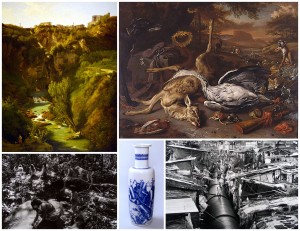
There has been a strong relationship between mankind and nature throughout history. But as time evolves, human populations grow and the cultivation of land as a resource increases so rapidly that nature can no longer catch up. This exhibition illustrates this connection between mankind and nature as it progresses through time with the idea of a harmonizing relationship that devolves into a struggle for dominance.
The porcelain vase of the Qing Dynasty and the painting of the falls at Tivoli begin this exhibition with a historical view of this relationship. Man has recognized in nature a necessity to survive and has benefited from earth’s resources. The two artworks display man’s cooperation with nature. Still life with Hunting Trophies further depicts the turning point for this complex relationship. Mankind eventually outgrew survival subsistence and began to use nature for recreational and social reasons, particularly game hunting. Here nature suddenly becomes not only a means but also a sign of wealth.
The last two pieces illustrate how the developing relationship between man and nature can be ambiguous or even detrimental. In the photo depicting the Marubo Indians, one might merely see people in a forest, peacefully cohabitating with the natural environment, but upon closer inspection they a family’s native existence under the threat of Western development. In the Drinking Water Pipeline, the viewer can see the hopelessness in an over-developed, poorly constructed urban setting in which humans have completely taken over. Both of these pictures suggest that humans have the power to either devastate nature or cooperate with it. The decision has never been more important.
Blue and White Rouleau Vase, Qing Dynasty, Kangxi reign c.16-18th century
Pierre-Athanase Chauvin, The Falls at Tivoli with the Temple Sibyl, c.1815
Jan Weenix’s Still Life with Hunting Trophies, 1680s-1690s
Sebastião Salgado, Scene near the Marubo Maronal village. 1998
Sebastião Salgado, Drinking Water Pipeline. Bombay, India, 1998